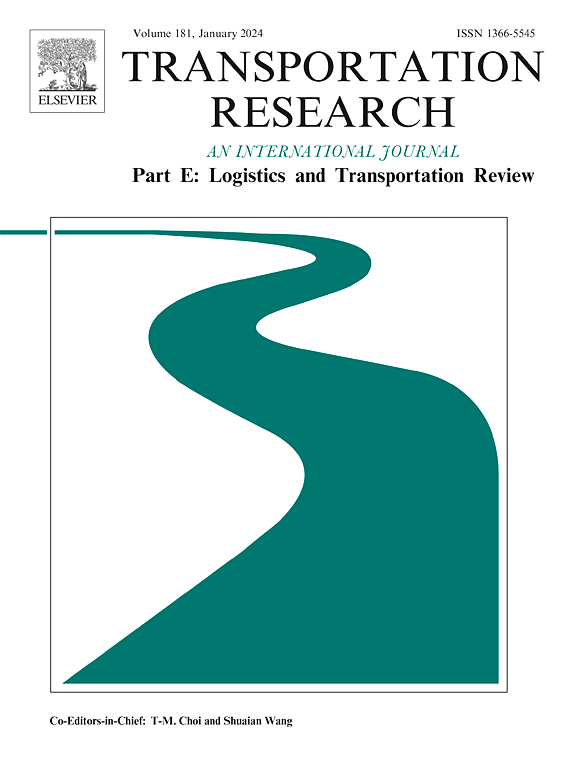Optimal pricing and collection decisions in a two-period closed-loop supply chain considering channel inconvenience
IF 8.3
1区 工程技术
Q1 ECONOMICS
Transportation Research Part E-Logistics and Transportation Review
Pub Date : 2025-02-01
DOI:10.1016/j.tre.2024.103869
引用次数: 0
Abstract
Improving recovery efficiency is a key concern for collectors in a closed-loop supply chain (CLSC) with remanufacturing, as customers often consider the inconvenience of recycling channels when returning used products. This issue profoundly affects collectors’ capacity to recover materials. In a two-period CLSC with remanufacturing, including a manufacturer and a retailer, we develop game-theoretical models in the centralized and decentralized scenarios and compare the optimal solutions, consumer surplus, social welfare and environmental impact of different models through analytical and numerical analysis. Our aim is to examine firms’ dynamic pricing strategies and collection investment decisions by considering customers’ perception of channel inconvenience. There are four main findings. Firstly, in the centralized model and the retailer collection model, the decision-maker lowers the retail price in the first period. However, in the competitive collection model, the manufacturer and the retailer raise the wholesale and retail prices in the first period, respectively. Secondly, in the retailer collection model, as the recycling revenue increases, the manufacturer, although not involved in collecting, the profit also increases due to the free-rider behavior. Thirdly, in the competitive collection model, when the remanufacturing cost savings is relatively high, the collection investment of the manufacturer is much larger than that of the retailer, resulting in the retailer failing to collect any product and giving up collecting. Finally, the collection competition improves the total collection rate and environmental performance but reduces the profit of the manufacturer and the retailer, as well as the consumer surplus and social welfare. Therefore, we design a two-part tariff contract to coordinate the decentralized model and effectively improve the performance of the supply chain.
考虑渠道不便的两周期闭环供应链的最优定价与收款决策
提高回收效率是回收商在再制造闭环供应链(CLSC)中关注的关键问题,因为客户在回收使用过的产品时经常考虑回收渠道的不便。这个问题深刻地影响到收集者回收材料的能力。在包含制造商和零售商的两期再制造CLSC中,我们建立了集中式和分散式两种模式下的博弈论模型,并通过解析和数值分析比较了不同模式下的最优解、消费者剩余、社会福利和环境影响。我们的目的是通过考虑客户对渠道不便的感知来检查公司的动态定价策略和集合投资决策。主要有四个发现。首先,在集中式模型和零售商集合模型中,决策者在第一期降低零售价格。而在竞争催收模式下,制造商和零售商在第一期分别提高批发和零售价格。其次,在零售商回收模式中,随着回收收入的增加,制造商虽然不参与回收,但由于搭便车行为,利润也会增加。第三,在竞争性回收模式中,当再制造成本节约较高时,制造商的回收投资远大于零售商的回收投资,导致零售商无法回收任何产品而放弃回收。最后,回收竞争提高了总回收率和环境绩效,但降低了制造商和零售商的利润,也降低了消费者剩余和社会福利。因此,我们设计了一个两部分的电价契约来协调分散模型,有效地提高供应链的绩效。
本文章由计算机程序翻译,如有差异,请以英文原文为准。
求助全文
约1分钟内获得全文
求助全文
来源期刊
CiteScore
16.20
自引率
16.00%
发文量
285
审稿时长
62 days
期刊介绍:
Transportation Research Part E: Logistics and Transportation Review is a reputable journal that publishes high-quality articles covering a wide range of topics in the field of logistics and transportation research. The journal welcomes submissions on various subjects, including transport economics, transport infrastructure and investment appraisal, evaluation of public policies related to transportation, empirical and analytical studies of logistics management practices and performance, logistics and operations models, and logistics and supply chain management.
Part E aims to provide informative and well-researched articles that contribute to the understanding and advancement of the field. The content of the journal is complementary to other prestigious journals in transportation research, such as Transportation Research Part A: Policy and Practice, Part B: Methodological, Part C: Emerging Technologies, Part D: Transport and Environment, and Part F: Traffic Psychology and Behaviour. Together, these journals form a comprehensive and cohesive reference for current research in transportation science.

 求助内容:
求助内容: 应助结果提醒方式:
应助结果提醒方式:


